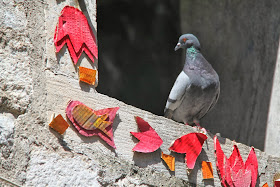
 Nestled below supposedly the wettest mountain in Europe, in what could be called the largest fjord in Southern Europe by some (Kotorski Zaliv is said to be a submerged river valley rather than a fjord), Kotor is an ancient fortified city with spectacular 4km city walls climbing up the steep cliffs of Lovcen and Orjen behind (dating from the 9th-15th century, the Venetian period).
Nestled below supposedly the wettest mountain in Europe, in what could be called the largest fjord in Southern Europe by some (Kotorski Zaliv is said to be a submerged river valley rather than a fjord), Kotor is an ancient fortified city with spectacular 4km city walls climbing up the steep cliffs of Lovcen and Orjen behind (dating from the 9th-15th century, the Venetian period). The Stari Grad (old city) is much the same layout as it has been for centuries, with narrow cobbled lanes leading to many small squares with simple orthodox churches that could barely fit a single household. Small shops and cafes decorate the squares and it is small and quaint, although very touristy (it is a regular cruise stop!). Sites include the 1166 St. Tryphon's Cathedral (which is actually a small church by cathedral standards!), St. Lucas Church, and the 1909 St. Nicholas Church (patron saint of sailors).
The Stari Grad (old city) is much the same layout as it has been for centuries, with narrow cobbled lanes leading to many small squares with simple orthodox churches that could barely fit a single household. Small shops and cafes decorate the squares and it is small and quaint, although very touristy (it is a regular cruise stop!). Sites include the 1166 St. Tryphon's Cathedral (which is actually a small church by cathedral standards!), St. Lucas Church, and the 1909 St. Nicholas Church (patron saint of sailors). |
| St. Tryphon's Cathedral |
 Beginning as Roman settlement Ascruvium and first mentioned in 168 BC, being on the Adriatic has meant that many different powers have come and gone in the area: from the Ostrogoths, Emperor Justinian built a fort in 535, the Saracens plundered it in 840, then the Dalmatians, Bulgarians then the Serbians, the Republic of Ragusa, Venice and the Ottomans. Various migrants and refugees diversified the city and together they suffered the plague (1572) and various earthquakes (1563, 1667, 1979 for example).
Beginning as Roman settlement Ascruvium and first mentioned in 168 BC, being on the Adriatic has meant that many different powers have come and gone in the area: from the Ostrogoths, Emperor Justinian built a fort in 535, the Saracens plundered it in 840, then the Dalmatians, Bulgarians then the Serbians, the Republic of Ragusa, Venice and the Ottomans. Various migrants and refugees diversified the city and together they suffered the plague (1572) and various earthquakes (1563, 1667, 1979 for example).Later under the Hapsburgs and the Napoleonic Kingdom of Italy, and a Russian squadron, the French's Illyrian Provinces, only to be captured by the British. WWI saw it being an Austro-Hungarian naval base, between the wars in Yugoslavia, and in WWII it was annexed by Italy (as the province of Cattaro) only to be returned to Yugoslavia again. In the mid 1800s its population was approximately equally divided between Serbians, Croats and Italians, but now it is composed of mostly Montenegrins with small Serbian and Croatian communities, 78% Orthodox and 13% Roman Catholic.
The pope visited in 2009 to commemorate the return of certain ancient relics (held by the Vatican for 1200 years!) so it is still an important Catholic heritage site.
 |
| Art installation in Kotor old city -- this clothesline is enormous |
Source: Lonely Planet Eastern Europe 8th Edition

















No comments:
Post a Comment